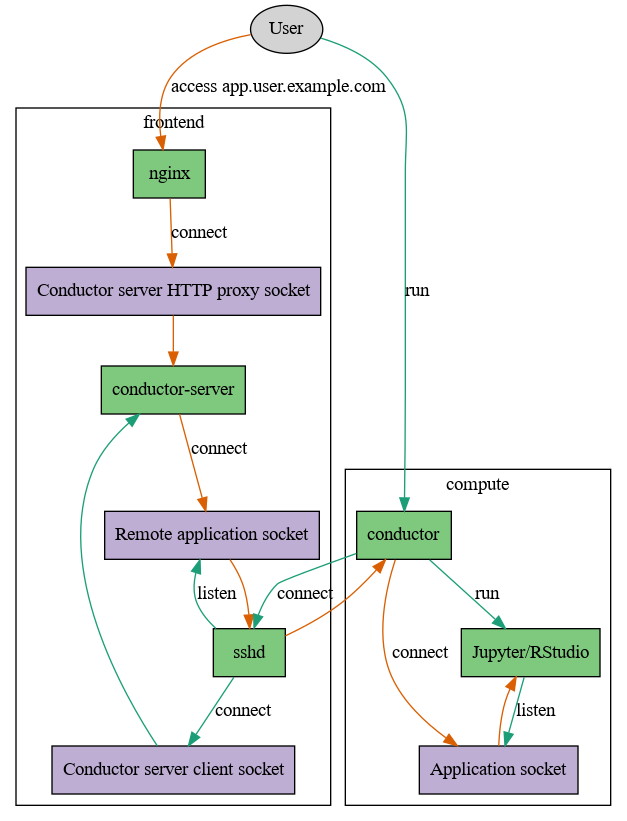conductor provides self-service application forwarding to a public web gateway for compute cluster users.
The basic flow is this: The user runs conductor on a
compute node, which then connects to the web frontend server via SSH and further
connects to the conductor-server’s client socket. The server will assign it
a directory to place its remote application socket into, which conductor
will listen on. If a webbrowser connects to conductor-server it will
connect to the remote application socket, which is forwarded by the user’s
conductor instance to the real application socket.
conductor is required, since a user must not bind his web application onto a port on the compute machine for two reasons: a) It is usually not accessible to him and b) other users on the same machine can access applications bound to localhost as well. UNIX domain sockets respect filesystem permissions and thus prevent b). Using SSH to forward connections is a well-established method for a) and leverages existing authentication mechanisms.
A guix package description is provided in contrib/conductor.scm, which can
be activated using:
guix package -f contrib/conductor.scmIf you’re using systemd copy the service file:
cp contrib/conductor.service /etc/systemd/system/conductor.serviceThen adjust the paths, add a user and group conductor and start it with
systemctl enable conductor && systemctl start conductor.
Finally a user can run software using
conductor host:2222/var/run/conductor/client app.socket -- my-applicationand connect using the host/authorization pair returned, i.e.
http://<urls[0]>/_conductor/auth/<auth>.
conductor-server supports cookie-based authentication, but it should not be
exposed to the internet directly, because it only speaks a very limited subset
of HTTP. A reverse-proxy setup is highly recommended.
Dropping socket files into a directory is used to simplify connection multiplexing. If we would use the connection to the client socket, we’d have to multiplex multiple incoming request streams over the same connection. Placing connect()’able UNIX domain sockets in a directory allows a 1:1 mapping for incoming to outgoing streams (and thus SSH handles multiplexing for us). Using a new non-guessable subdirectory with tight permissions for every new client should make this reasonably safe.
You can run both server and client locally for development and
testing. Make sure you can ssh into localhost without interactive
authorization (i.e. no password). To run the server:
openssl req -new -newkey -x509 -days 365 -nodes -out cert.pem -keyout cert.key
openssl req -new -newkey -x509 -days 365 -nodes -out client.pem -keyout client.key
conductor-server \
-r run \
--ssl-cert-file cert.pem \
--ssl-key-file cert.key \
-d '{key}-{user}.localhost:8888' \
--ssl-allowed-clients client.pem \
-vThen run any client like this simple HTTP server:
import asyncio, sys, os
payload = b'a'*10000
async def cb (reader, writer):
print ('yep')
sys.stdout.flush ()
while True:
l = await reader.readline ()
if l == b'\r\n' or not l:
break
#print (l)
writer.write (b'HTTP/1.0 200 OK\r\nConnection: close\r\n\r\n')
writer.write (payload)
writer.close ()
try:
await writer.wait_closed ()
except:
pass
async def main ():
socketpath = sys.argv[1]
await asyncio.start_unix_server (cb, socketpath)
os.chmod (socketpath, 0o0600)
loop = asyncio.get_event_loop ()
loop.run_until_complete (main ())
loop.run_forever ()And execute it:
env CONDUCTOR_TOKEN=test conductor \
-k server \
localhost`pwd`/run/client /tmp/server.sock -- \
python unixserver.py /tmp/server.sockYou can access it with curl:
curl -b 'authorization=test' -L -D - \
-k \
--cert client.pem --key client.key \
https://server-$USER.localhost:8888/